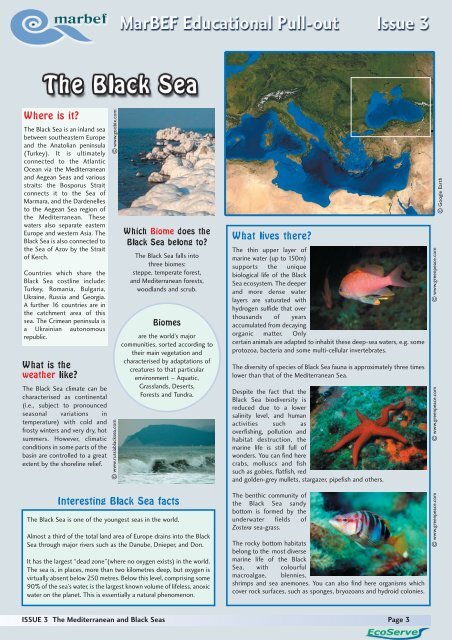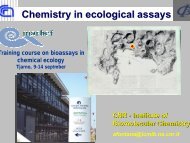Mediterranean Sea and Black Sea - MarBEF
Mediterranean Sea and Black Sea - MarBEF
Mediterranean Sea and Black Sea - MarBEF
Create successful ePaper yourself
Turn your PDF publications into a flip-book with our unique Google optimized e-Paper software.
Where is it?<br />
The <strong>Black</strong> <strong>Sea</strong> is an inl<strong>and</strong> sea<br />
between southeastern Europe<br />
<strong>and</strong> the Anatolian peninsula<br />
(Turkey). It is ultimately<br />
connected to the Atlantic<br />
Ocean via the <strong>Mediterranean</strong><br />
<strong>and</strong> Aegean <strong>Sea</strong>s <strong>and</strong> various<br />
straits: the Bosporus Strait<br />
connects it to the <strong>Sea</strong> of<br />
Marmara, <strong>and</strong> the Dardenelles<br />
to the Aegean <strong>Sea</strong> region of<br />
the <strong>Mediterranean</strong>. These<br />
waters also separate eastern<br />
Europe <strong>and</strong> western Asia. The<br />
<strong>Black</strong> <strong>Sea</strong> is also connected to<br />
the <strong>Sea</strong> of Azov by the Strait<br />
of Kerch.<br />
Countries which share the<br />
<strong>Black</strong> <strong>Sea</strong> costline include:<br />
Turkey, Romania, Bulgaria,<br />
Ukraine, Russia <strong>and</strong> Georgia.<br />
A further 16 countries are in<br />
the catchment area of this<br />
sea. The Crimean peninsula is<br />
a Ukrainian autonomous<br />
republic.<br />
What is the<br />
weather like?<br />
The <strong>Black</strong> <strong>Sea</strong> climate can be<br />
characterised as continental<br />
(i.e., subject to pronounced<br />
seasonal variations in<br />
temperature) with cold <strong>and</strong><br />
frosty winters <strong>and</strong> very dry, hot<br />
summers. However, climatic<br />
conditions in some parts of the<br />
basin are controlled to a great<br />
extent by the shoreline relief.<br />
© www.goobix.com<br />
© www.russiablacksea.com<br />
Which Biome does the<br />
<strong>Black</strong> <strong>Sea</strong> belong to?<br />
The <strong>Black</strong> <strong>Sea</strong> falls into<br />
three biomes:<br />
steppe, temperate forest,<br />
<strong>and</strong> <strong>Mediterranean</strong> forests,<br />
woodl<strong>and</strong>s <strong>and</strong> scrub.<br />
Biomes<br />
are the world’s major<br />
communities, sorted according to<br />
their main vegetation <strong>and</strong><br />
characterised by adaptations of<br />
creatures to that particular<br />
environment – Aquatic,<br />
Grassl<strong>and</strong>s, Deserts,<br />
Forests <strong>and</strong> Tundra.<br />
Interesting <strong>Black</strong> <strong>Sea</strong> facts<br />
The <strong>Black</strong> <strong>Sea</strong> is one of the youngest seas in the world.<br />
Almost a third of the total l<strong>and</strong> area of Europe drains into the <strong>Black</strong><br />
<strong>Sea</strong> through major rivers such as the Danube, Dnieper, <strong>and</strong> Don.<br />
It has the largest “dead zone”(where no oxygen exists) in the world.<br />
The sea is, in places, more than two kilometres deep, but oxygen is<br />
virtually absent below 250 metres. Below this level, comprising some<br />
90% of the sea’s water, is the largest known volume of lifeless, anoxic<br />
water on the planet. This is essentially a natural phenomenon.<br />
What lives there?<br />
The thin upper layer of<br />
marine water (up to 150m)<br />
supports the unique<br />
biological life of the <strong>Black</strong><br />
<strong>Sea</strong> ecosystem. The deeper<br />
<strong>and</strong> more dense water<br />
layers are saturated with<br />
hydrogen sulfide that over<br />
thous<strong>and</strong>s of years<br />
accumulated from decaying<br />
organic matter. Only<br />
certain animals are adapted to inhabit these deep-sea waters, e.g. some<br />
protozoa, bacteria <strong>and</strong> some multi-cellular invertebrates.<br />
The diversity of species of <strong>Black</strong> <strong>Sea</strong> fauna is approximately three times<br />
lower than that of the <strong>Mediterranean</strong> <strong>Sea</strong>.<br />
Despite the fact that the<br />
<strong>Black</strong> <strong>Sea</strong> biodiversity is<br />
reduced due to a lower<br />
salinity level, <strong>and</strong> human<br />
activities such as<br />
overfishing, pollution <strong>and</strong><br />
habitat destruction, the<br />
marine life is still full of<br />
wonders. You can find here<br />
crabs, molluscs <strong>and</strong> fish<br />
such as gobies, flatfish, red<br />
<strong>and</strong> golden-grey mullets, stargazer, pipefish <strong>and</strong> others.<br />
The benthic community of<br />
the <strong>Black</strong> <strong>Sea</strong> s<strong>and</strong>y<br />
bottom is formed by the<br />
underwater fields of<br />
Zostera sea-grass.<br />
The rocky bottom habitats<br />
belong to the most diverse<br />
marine life of the <strong>Black</strong><br />
<strong>Sea</strong>, with colourful<br />
macroalgae, blennies,<br />
shrimps <strong>and</strong> sea anemones. You can also find here organisms which<br />
cover rock surfaces, such as sponges, bryozoans <strong>and</strong> hydroid colonies.<br />
ISSUE 3 The <strong>Mediterranean</strong> <strong>and</strong> <strong>Black</strong> <strong>Sea</strong>s Page 3<br />
© www.greenpeace.com © www.greenpeace.com<br />
© www.greenpeace.com<br />
© Google Earth




